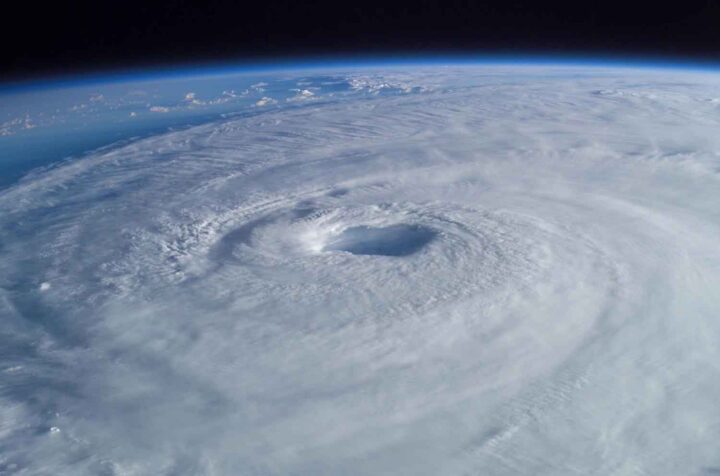News
GFDL and SOFAR are Advancing Marine Weather Forecasting to Improve Safety at Sea
 December 3, 2025 – GFDL and Sofar Ocean, a leading ocean intelligence platform, have partnered to build innovative modeling systems that advance the state-of-the-art in marine weather forecasting and boost safety at sea.
December 3, 2025 – GFDL and Sofar Ocean, a leading ocean intelligence platform, have partnered to build innovative modeling systems that advance the state-of-the-art in marine weather forecasting and boost safety at sea.
Research Highlight
Projected Response of Santa Ana Winds over Southern California to global warming by a high-resolution climate model
 September 29, 2025 – Santa Ana winds (SAWs) are hot and dry winds that blow from the Great Basin (Nevada and adjacent areas) to coastal Southern California. SAW events usually last several days, and occur in Fall and Winter (see upper left panel of Figure). These hot, dry winds increase the likelihood and intensity of wildfires and their associated damage.
September 29, 2025 – Santa Ana winds (SAWs) are hot and dry winds that blow from the Great Basin (Nevada and adjacent areas) to coastal Southern California. SAW events usually last several days, and occur in Fall and Winter (see upper left panel of Figure). These hot, dry winds increase the likelihood and intensity of wildfires and their associated damage.
News
GFDL’s Legacy of Awards and Honors
 March 18, 2025 – GFDL has a rich legacy of excellence and innovation, which is reflected in the exceptional achievements of our scientists and the recognition they have received. The lab has been creating opportunities for exploration and collaboration for more than 65 years and our scientists are among the most influential and decorated in climate science. We are proud to be home to dozens of recipients of prestigious awards, including the Nobel Prize and the Crafoord Prize, as well as members of the National Academy of Sciences. Scientists listed here performed their award-winning work at GFDL.
March 18, 2025 – GFDL has a rich legacy of excellence and innovation, which is reflected in the exceptional achievements of our scientists and the recognition they have received. The lab has been creating opportunities for exploration and collaboration for more than 65 years and our scientists are among the most influential and decorated in climate science. We are proud to be home to dozens of recipients of prestigious awards, including the Nobel Prize and the Crafoord Prize, as well as members of the National Academy of Sciences. Scientists listed here performed their award-winning work at GFDL.
Award
Vaishali Naik Receives AGU 2025 Turco Lectureship Award
 September 29, 2025 – In recognition of her work advancing the understanding of atmospheric chemistry and climate, the Atmospheric Sciences section of the American Geophysical Union (AGU) has awarded Vaishali Naik, a physical scientist in the Earth System Processes and Interactions Division, the 2025 Future Horizons in Climate Science: Turco Lectureship.
September 29, 2025 – In recognition of her work advancing the understanding of atmospheric chemistry and climate, the Atmospheric Sciences section of the American Geophysical Union (AGU) has awarded Vaishali Naik, a physical scientist in the Earth System Processes and Interactions Division, the 2025 Future Horizons in Climate Science: Turco Lectureship.
Research Highlight
ENSO-Driven Variability in Ozone Sources and Its Impact on Tropospheric Ozone Radiative Forcing
 August 18, 2025 – Ozone is a powerful greenhouse gas that efficiently traps heat, especially in the tropical upper troposphere. In this study, the authors used GFDL’s Atmospheric Model v4.1 (AM4.1) to investigate how the El Niño-Southern Oscillation (ENSO) influences three key processes affecting ozone: biomass burning, lightning-produced nitrogen oxides, and stratospheric ozone intrusion.
August 18, 2025 – Ozone is a powerful greenhouse gas that efficiently traps heat, especially in the tropical upper troposphere. In this study, the authors used GFDL’s Atmospheric Model v4.1 (AM4.1) to investigate how the El Niño-Southern Oscillation (ENSO) influences three key processes affecting ozone: biomass burning, lightning-produced nitrogen oxides, and stratospheric ozone intrusion.
Research Highlight
Western United States wintertime precipitation response to warming: an assessment in a global storm-resolving model
 July 23, 2025 – Winter high-elevation snowpack is a primary source of freshwater in the Western United States. Focusing on wintertime precipitation in the coastal western U. S., the authors evaluated simulations from a global storm-resolving model, the eXperimental System for High-resolution prediction on Earth-to-Local Domains (X-SHiELD).
July 23, 2025 – Winter high-elevation snowpack is a primary source of freshwater in the Western United States. Focusing on wintertime precipitation in the coastal western U. S., the authors evaluated simulations from a global storm-resolving model, the eXperimental System for High-resolution prediction on Earth-to-Local Domains (X-SHiELD).
Award
GFDL Director V. Ramaswamy Elected to National Academy of Sciences
 July 8, 2025 – Venkatachalam “Ram” Ramaswamy, Director of GFDL, has been elected to the National Academy of Sciences (NAS). His election to the NAS highlights a career dedicated to foundational research, scientific leadership, productive collaborations, and the advancement of computational Earth System models, producing practical benefits for society and trustworthy information for real-world decision-making.
July 8, 2025 – Venkatachalam “Ram” Ramaswamy, Director of GFDL, has been elected to the National Academy of Sciences (NAS). His election to the NAS highlights a career dedicated to foundational research, scientific leadership, productive collaborations, and the advancement of computational Earth System models, producing practical benefits for society and trustworthy information for real-world decision-making.
Research Highlight
Opposing trends in winter Atmospheric River over the Western and Eastern US during the past four decades
 June 30, 2025 – Winter atmospheric rivers (ARs) are crucial for water supply and extreme weather events in both the western (WUS) and eastern United States (EUS), yet their long-term trends and interactions remain unclear. The authors address this by analyzing multiple observational AR datasets spanning the past four decades.
June 30, 2025 – Winter atmospheric rivers (ARs) are crucial for water supply and extreme weather events in both the western (WUS) and eastern United States (EUS), yet their long-term trends and interactions remain unclear. The authors address this by analyzing multiple observational AR datasets spanning the past four decades.
News
GFDL Scientists Author one of Most-Viewed Papers for Leading Scientific Journal in 2023
 June 18, 2025 – Jing Feng, David J. Paynter (GFDL), and Raymond Menzel (formerly GFDL) were recognized for authoring one of the Top 10% Most-Viewed Papers in Journal of Geophysical Research: Atmospheres in 2023. Their paper, “How a Stable Greenhouse Effect on Earth Is Maintained Under Global Warming,” examines how Earth maintains energy balance as surface temperatures rise.
June 18, 2025 – Jing Feng, David J. Paynter (GFDL), and Raymond Menzel (formerly GFDL) were recognized for authoring one of the Top 10% Most-Viewed Papers in Journal of Geophysical Research: Atmospheres in 2023. Their paper, “How a Stable Greenhouse Effect on Earth Is Maintained Under Global Warming,” examines how Earth maintains energy balance as surface temperatures rise.
Research Highlight
Closing the gap — Hurricane Prediction Advances in the US FV3-based Models
 June 10, 2025 – Hurricanes are one of the most destructive natural events on Earth. Improving the skill of hurricane forecasts, especially for those in the North Atlantic basin, has always been an important objective for government weather forecast agencies, emergency managers, and the atmospheric science research community in the United States.
June 10, 2025 – Hurricanes are one of the most destructive natural events on Earth. Improving the skill of hurricane forecasts, especially for those in the North Atlantic basin, has always been an important objective for government weather forecast agencies, emergency managers, and the atmospheric science research community in the United States.
News
NOAA ocean outlook projects cooler deep waters for Gulf of Maine
 May 28, 2025 – The Gulf of Maine, historically one of the fastest-warming ocean regions in the world, is predicted to experience cooler bottom-water temperatures this spring and summer, according to a new experimental outlook developed by NOAA scientists. Initial signs of this shift were reported by NOAA’s Northeast Fisheries Science Center link and documented in the NOAA Fisheries 2025 New England State of the Ecosystem Report.
May 28, 2025 – The Gulf of Maine, historically one of the fastest-warming ocean regions in the world, is predicted to experience cooler bottom-water temperatures this spring and summer, according to a new experimental outlook developed by NOAA scientists. Initial signs of this shift were reported by NOAA’s Northeast Fisheries Science Center link and documented in the NOAA Fisheries 2025 New England State of the Ecosystem Report.


